Unit 4 Where’s my schoolbag? 单元表格式教案(4课时)
文档属性
| 名称 | Unit 4 Where’s my schoolbag? 单元表格式教案(4课时) | 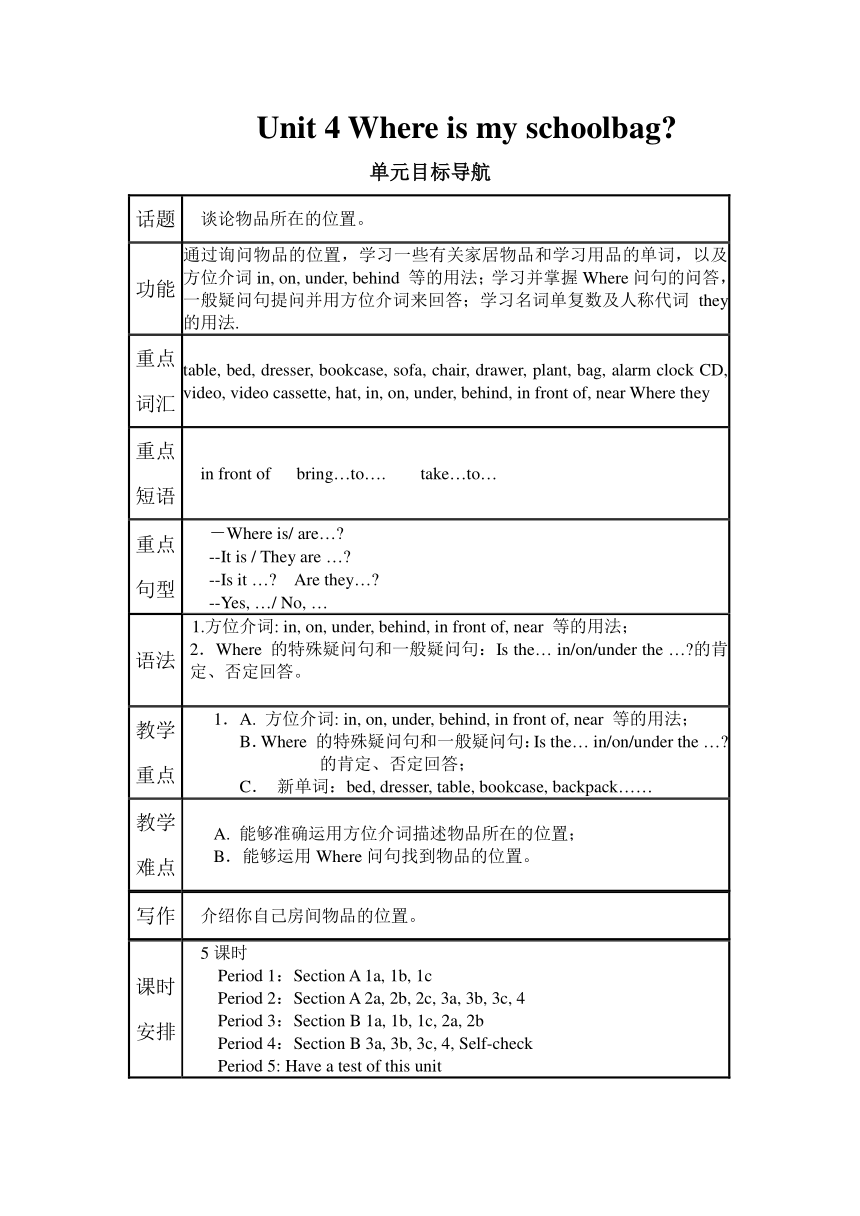 | |
| 格式 | zip | ||
| 文件大小 | 32.9KB | ||
| 资源类型 | 教案 | ||
| 版本资源 | 人教新目标(Go for it)版 | ||
| 科目 | 英语 | ||
| 更新时间 | 2018-08-06 15:42:08 | ||
图片预览

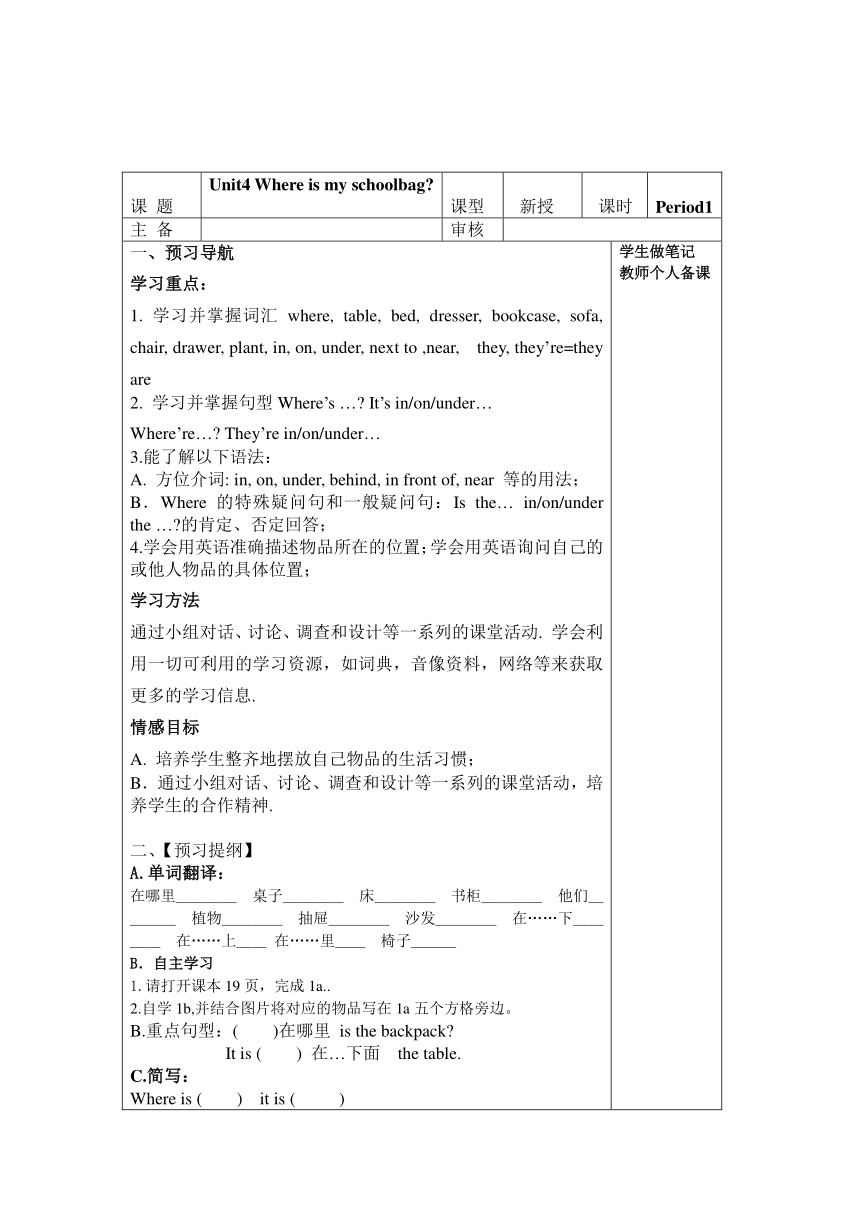
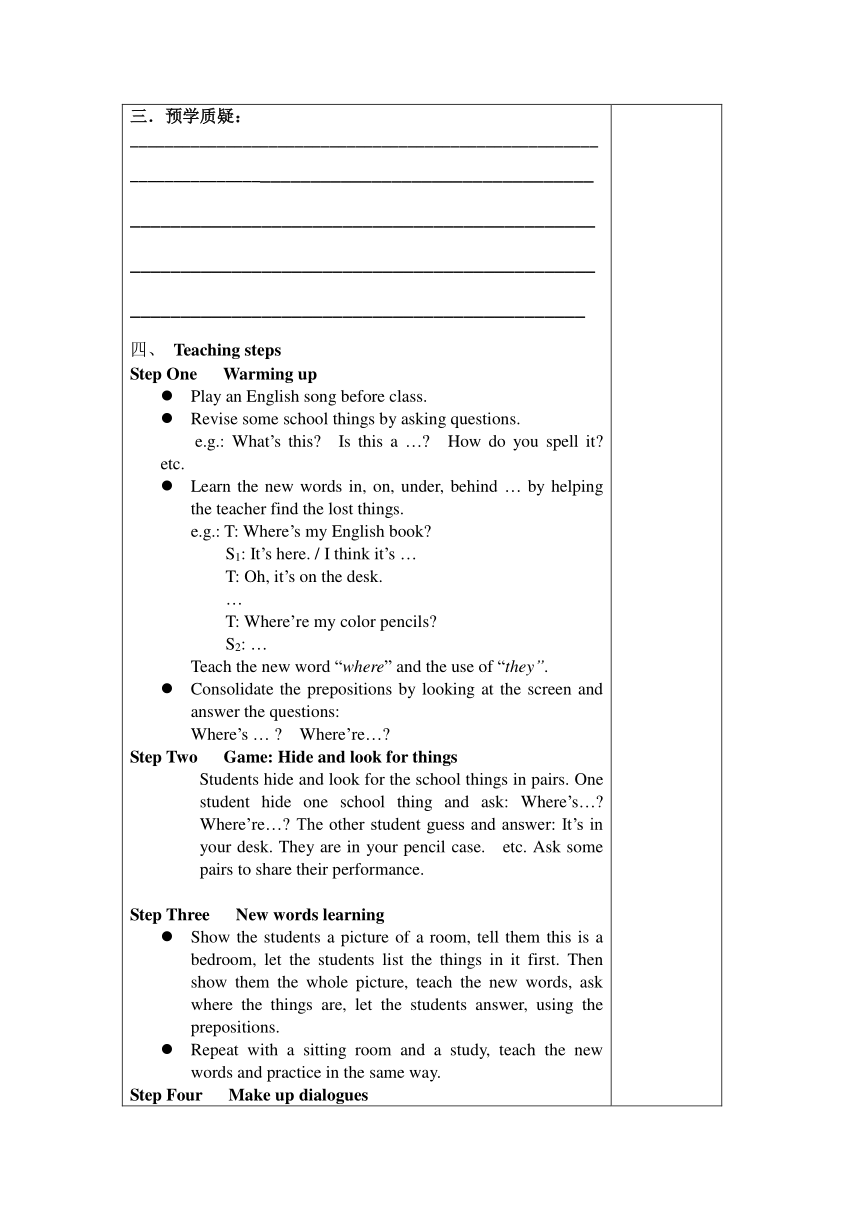
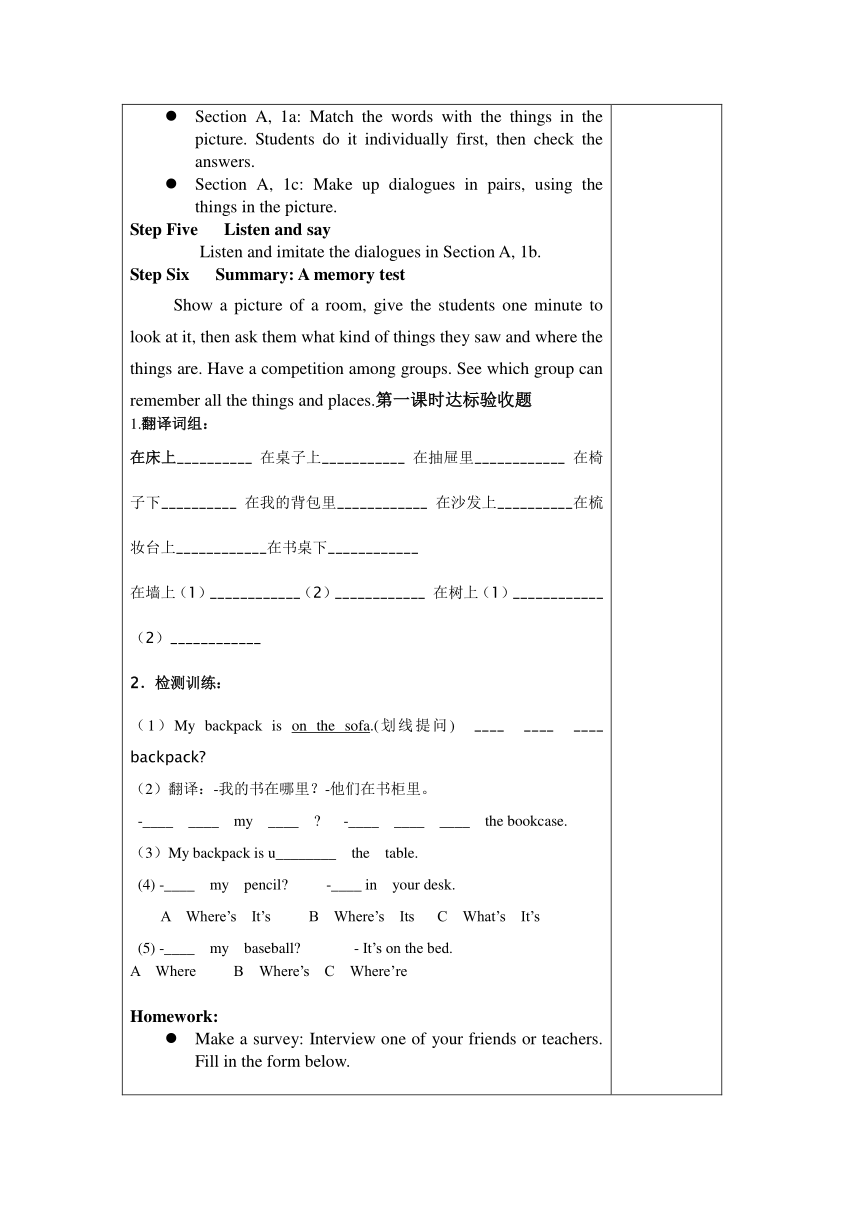
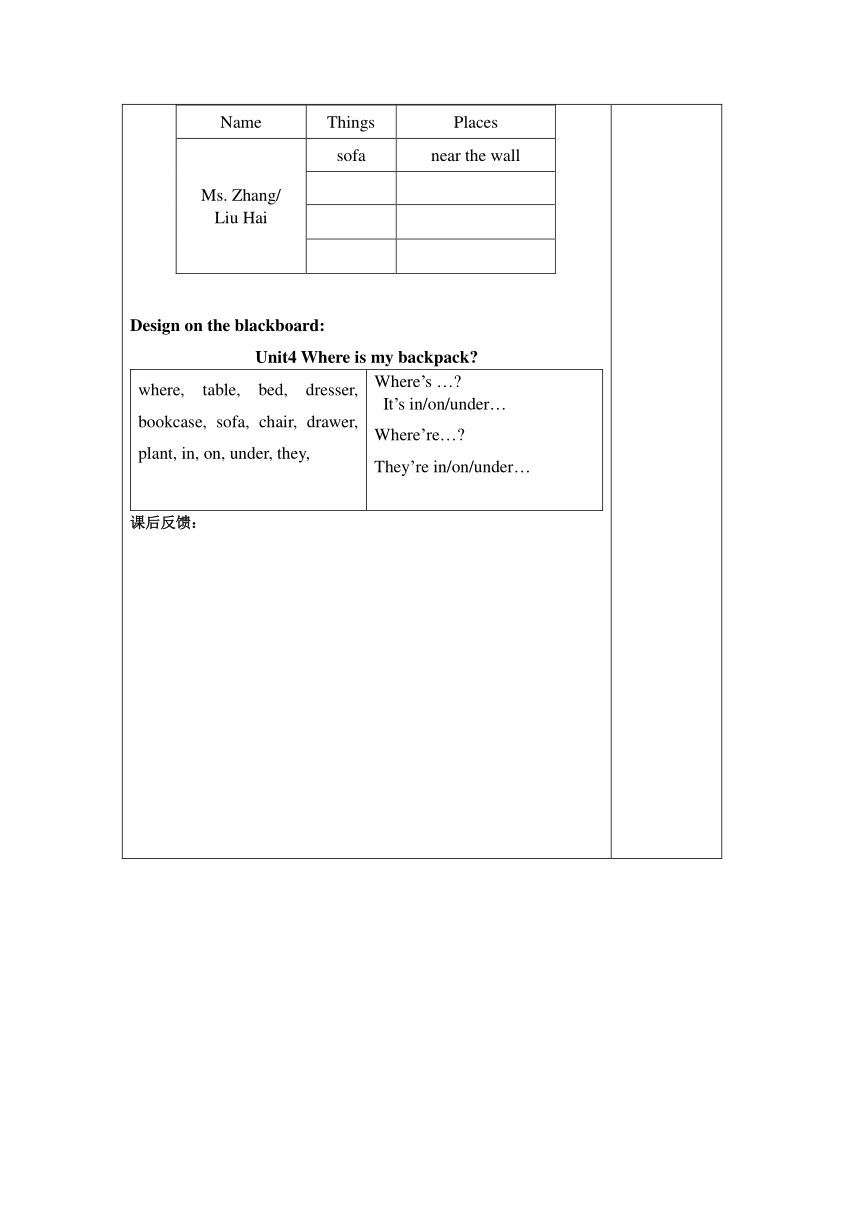
文档简介
Unit 4 Where is my schoolbag?
话题
谈论物品所在的位置。
功能
通过询问物品的位置,学习一些有关家居物品和学习用品的单词,以及方位介词in, on, under, behind 等的用法;学习并掌握Where问句的问答,一般疑问句提问并用方位介词来回答;学习名词单复数及人称代词they 的用法.
重点词汇
table, bed, dresser, bookcase, sofa, chair, drawer, plant, bag, alarm clock CD, video, video cassette, hat, in, on, under, behind, in front of, near Where they
重点短语
in front of bring…to…. take…to…
重点句型
-Where is/ are…?
--It is / They are …?
--Is it …? Are they…?
--Yes, …/ No, …
语法
1.方位介词: in, on, under, behind, in front of, near 等的用法;
2.Where 的特殊疑问句和一般疑问句:Is the… in/on/under the …?的肯定、否定回答。
教学重点
A. 方位介词: in, on, under, behind, in front of, near 等的用法;
B.Where 的特殊疑问句和一般疑问句:Is the… in/on/under the …?的肯定、否定回答;
C. 新单词:bed, dresser, table, bookcase, backpack……
教学难点
A. 能够准确运用方位介词描述物品所在的位置;
B.能够运用Where问句找到物品的位置。
写作
介绍你自己房间物品的位置。
课时 安排
5课时
Period 1:Section A 1a, 1b, 1c
Period 2:Section A 2a, 2b, 2c, 3a, 3b, 3c, 4
Period 3:Section B 1a, 1b, 1c, 2a, 2b
Period 4:Section B 3a, 3b, 3c, 4, Self-check
Period 5: Have a test of this unit
单元目标导航
课 题
Unit4 Where is my schoolbag?
课型
新授
课时
Period1
主 备
审核
一、预习导航
学习重点:
1. 学习并掌握词汇where, table, bed, dresser, bookcase, sofa, chair, drawer, plant, in, on, under, next to ,near, they, they’re=they are
2. 学习并掌握句型Where’s …? It’s in/on/under…
Where’re…? They’re in/on/under…
3.能了解以下语法:
A. 方位介词: in, on, under, behind, in front of, near 等的用法;
B.Where 的特殊疑问句和一般疑问句:Is the… in/on/under the …?的肯定、否定回答;
4.学会用英语准确描述物品所在的位置;学会用英语询问自己的或他人物品的具体位置;
学习方法
通过小组对话、讨论、调查和设计等一系列的课堂活动. 学会利用一切可利用的学习资源,如词典,音像资料,网络等来获取更多的学习信息.
情感目标
A. 培养学生整齐地摆放自己物品的生活习惯;
B.通过小组对话、讨论、调查和设计等一系列的课堂活动,培养学生的合作精神.
二、【预习提纲】
A.单词翻译:
在哪里____ 桌子____ 床____ 书柜____ 他们____ 植物____ 抽屉____ 沙发____ 在……下____ 在……上__ 在……里__ 椅子___
B.自主学习
1.请打开课本19页,完成1a..
2.自学1b,并结合图片将对应的物品写在1a五个方格旁边。
B.重点句型:( )在哪里 is the backpack?
It is ( ) 在…下面 the table.
C.简写:
Where is ( ) it is ( )
三.预学质疑:
_______________________________________________________________________________________________________________________________________________________________________________________________________________________________________________
四、 Teaching steps
Step One Warming up
Play an English song before class.
Revise some school things by asking questions.
e.g.: What’s this? Is this a …? How do you spell it? etc.
Learn the new words in, on, under, behind … by helping the teacher find the lost things.
e.g.: T: Where’s my English book?
S1: It’s here. / I think it’s …
T: Oh, it’s on the desk.
…
T: Where’re my color pencils?
S2: …
Teach the new word “where” and the use of “they”.
Consolidate the prepositions by looking at the screen and answer the questions:
Where’s … ? Where’re…?
Step Two Game: Hide and look for things
Students hide and look for the school things in pairs. One student hide one school thing and ask: Where’s…? Where’re…? The other student guess and answer: It’s in your desk. They are in your pencil case. etc. Ask some pairs to share their performance.
Step Three New words learning
Show the students a picture of a room, tell them this is a bedroom, let the students list the things in it first. Then show them the whole picture, teach the new words, ask where the things are, let the students answer, using the prepositions.
Repeat with a sitting room and a study, teach the new words and practice in the same way.
Step Four Make up dialogues
Section A, 1a: Match the words with the things in the picture. Students do it individually first, then check the answers.
Section A, 1c: Make up dialogues in pairs, using the things in the picture.
Step Five Listen and say
Listen and imitate the dialogues in Section A, 1b.
Step Six Summary: A memory test
Show a picture of a room, give the students one minute to look at it, then ask them what kind of things they saw and where the things are. Have a competition among groups. See which group can remember all the things and places.第一课时达标验收题
1.翻译词组:
在床上__________ 在桌子上___________ 在抽屉里____________ 在椅子下__________ 在我的背包里____________ 在沙发上__________在梳妆台上____________在书桌下____________
在墙上(1)____________(2)____________ 在树上(1)____________(2)____________
2.检测训练:
(1)My backpack is on the sofa.(划线提问) ____ ____ ____ backpack?
(2)翻译:-我的书在哪里?-他们在书柜里。
-____ ____ my ____ ? -____ ____ ____ the bookcase.
(3)My backpack is u________ the table.
(4) -____ my pencil? -____ in your desk.
A Where’s It’s B Where’s Its C What’s It’s
(5) -____ my baseball? - It’s on the bed.
A Where B Where’s C Where’re
Homework:
Make a survey: Interview one of your friends or teachers. Fill in the form below.
Name
Things
Places
Ms. Zhang/
Liu Hai
sofa
near the wall
Design on the blackboard:
Unit4 Where is my backpack?
where, table, bed, dresser, bookcase, sofa, chair, drawer, plant, in, on, under, they,
Where’s …?
It’s in/on/under…
Where’re…?
They’re in/on/under…
课后反馈:
学生做笔记
教师个人备课
课 题
Unit4 Where is my schoolbag?
课型
新授
课时
Period2
主 备
审核
一、预习导航
学习重点:
1. 学习并掌握词汇 on don’t=do not know bag
2. 学习并掌握句型Where is…? It’s on/in/under…
Where are…? They’re in/on/under…?
3.能了解以下语法:
Is the book / Are the books on the desk? Yes,… / No,…
I don’t know.
4.掌握名词单复数及人称代词they的用法。
5. 学会用英语询问自己的或他人物品的具体位置;
6. 学会用英语准确描述物品所在的位置;
学习方法
学会与他人合作交流,并能把语言材料用到真实的生活中去;
情感目标
1.培养学生整齐地摆放自己物品的生活习惯;
2.培养学生的合作精神。
二、【预习提纲】
A.单词翻译:知道( ) 书包( )
B. 完成句子
1.他的书包在桌子下面。
His ____________ is ____________ the table.
2.我的字典在沙发上。
____________ dictionary is ____________ the sofa.
3.我的棒球在哪里?
____________ my baseball?
4.我的钥匙在梳妆台上吗?没有。
____________ my ____________ on the dresser?No,____________ ____________.
5.台灯在床边上吗?是的,在床边。
Is the light ____________ ____________ the bed?Yes,____________ ____________.
C.简写:do not = ( ) where are = ( )
三.预学质疑:
____________________________________________________________________________________________________________________________________________________
四、 Teaching steps
Step One Warming up
Chatting. Chat with the students about the things around the room by showing them pictures. Ask the students to spell the new words.
Step Two Listen and imitate
Section A, 2a. Revise what the things are. Play the tape for students and let them number them.
Section A, 2b. Play the tape again, students number the things [1-6] in the picture. Imitate the dialogues.
Step Three A guessing game
A guessing game. Show the students a picture of a room with a few things in it. Have them guess the places of the other things.
e.g.: T: There is a bookcase in it. Is the bookcase near the bed?
Ss: Yes, it is. / No, it isn’t.
Write the general question and the answers on the blackboard.
Step Four Pairwork
Section A, 2c. Look at the picture in 2b again. Students use general questions to ask and answer about the things in it.
Step Five Game: Find the difference
Section A, 4. Student A looks at Picture 1 ( Textbook P21. 4), Student B looks at Picture 2 ( Textbook P19, 1a). Ask and answer in pairs and fill in the form.
e.g.: SA: Where is the backpack? Is it under the table?
SB: No, it isn’t. It’s on the table.
Things
Picture 1
Picture 2
backpack
under the table
on the table
pencil case
books
keys
dog
Ask some students to report their answer like this: In Picture 1, the pencil case is … In Picture 2, the pencil case is…; In Picture 1, the books are … In Picture 2, the books are …
Step Six Practice the drill “Where is / are…?”
Present short dialogues, using pictures or objects to help.
Dialogue 1:
A: Where’s my bag?
B: I don’t know. Is it on the sofa?
A: No, it isn’t.
Dialogue 2:
A: Where’re my books?
B: I don’t know. Are they on the bed?
A: Yes, they are.
Teach “don’t =do not”, “ know”.
Let the students make similar dialogues according to the pictures in Section A, 3a&3c.
Put the dialogue in the right order.( Section A, 3a.)
Step Seven Summary:
本课时主要学习一些室内物体名词:table,bed,dresser,bookcase,
sofa,chair,baseball,drawer,plant;学习运用Where引导的疑问句询问物体的位置;学习运用方位介词on,in,under,behind等谈论物体的位置。
第二课时达标验收题
一..从Ⅱ中找出与Ⅰ相对应的句子
Ⅰ Ⅱ
( )1.Is that boy your brother? A.No,it isn't.
( )2.Where is his hat? B.She's my grandmother.
( )3.Is her photo in the drawer? C.They're under the bed.
( )4.Who's that old woman? D.Yes,he is.
( )5.Where are my shoes? E.Sorry,I don't know.
二..选择填空
1.____________ your hat?
A.Where B.Where're C.Where's
2.Is his pencil case ____________ the drawer?
A.in B.at C.behind
3.Can you ____________ something to school?
A.need B.take C.bring
4.The CDs ____________ in the drawer.
A.am B.is C.are
5.I have an alarm clock.It's ____________ video cassette and the computer.
A.between B.behind C.under
6.—Are the shoes under your bed?
—____________.
A.Yes,it is B.Yes,they are C.No,it isn't
7.—____________ that?
—It's my sister Jane.
A.Who's B.What's C.Where's
8.The windows are ____________ the wall.
A.under B.in C.on
Homework:
Finish off the exercises in the exercise book.
Act out the dialogues. (Section A, 2a & 2b.)
Design on the blackboard:
Unit4 Where is my backpack?
on
don’t=do not
know
bag
in front of
Is the book …?
Are the books on the desk?
Yes,…
No,…
I don’t know.
课后反馈:
学生做笔记
教师个人备课
课 题
Unit4 Where is my schoolbag?
课型
新授
课时
Period3
主 备
审核
一、预习导航
知识与能力:
1. 学习并掌握词汇: math book alarm clock CD computer game video tape hat
2 学习并掌握句型The math book is on the desk.
Mary’s CDs are in the drawer.
3.能了解以下语法:定冠词the 的用法。
名词单复数在句型中的用法。
4.学会用英语准确描述物品所在的位置
5.可以给他人介绍自己的房间。
学习方法:
1.名词单复数在句型中的用法。
2.听力训练1a中圈单词和2b中写句子.
3.看句子画出房间。
情感目标:1.能够合理地描述和设计房间。
2.培养学生整齐地摆放自己物品的生活习惯。
3通过小组对话、讨论、调查和设计等一系列的课堂活动,培养学生的合作精神。
二、【预习提纲】
A.单词翻译:math book---------, alarm clock--------- ,
CD---- ,computer game -------
video tape -------, hat--------
B.重点句型翻译:1.The math book is on the dresser.
2.The CDs are on the bookcase.
三.预学质疑:
__________________________________________________________________________________________________________________________________________________________________________________________________
四、 Teaching steps
Step One Warming up
Ask some pairs to act out the dialogues in Section A, 4.
Step Two New words learning
Show the students a picture of a room. Let the students say like this:
The ID card is on the table.
The books are on the chair.
Let some able students list some new words. Practice reading them.
Match the new words with the things in the picture. (Section B, 1a.)
Pair work. Talk about the picture. ( Section B, 1b&1c.)
Step Three Listen, circle and write
Play the tape twice for students to listen and circle the things Tommy wants from his room. Check the answers. ( Section B, 2a. )
Listen again. Write down the sentence about where Tommy’s things are. Check the answers. ( Section B, 2b.)
Step Four: Oral English
Things
Places
backpack
on the chair
pen
in the pencil case
notebook
on the bookcase/in the backpack/on the desk
keys
in the drawer/bag
dictionary
on the bookcase/in the backpack/on the desk
alarm clock
on the bed/desk
socks
in the drawer
pictures
on the wall
shoes
under the bed
CDs
on the desk/bookcase
Step Five: Read sentences and draw pictures(Self check. 3 )
Or one student describe his or her room , the other student draw the room.
Step Summary:
In this class, we should remember some family objects and give the preposition about them.
第一课时达标验收题
一.选择正确的选项
( )1.Is your photo in the drawer? ________.
A.Yes, I am B.No,it is C.Yes,it is D.No,I’m not
( )2.Where are your brothers? ________.
A.He is at home B.He is in his room
C.Yes,they are D.I don’t know
( )3.________ my baseball? It’s under the chair.
A.Where B.Where’s C.Where’re D.Where are
二.填空
1 .Where( ) my / the baseball?
2 .It( )in the backpack.
3 .Where ( )my / the books?
4 .They( )on the sofa.
Design on the blackboard:
Unit4 Where is my backpack?
math book,alarm clock The math book is on the dresser.
CD computer game The CDs are on the bookcase.
video tape , hat
课后反馈:
学生做笔记
教师个人备课
课 题
Unit4 Where is my schoolbag?
课型
新授
课时
Period4
主 备
审核
一、预习导航
知识与能力
1. 学习并掌握短语take…to.. bring…to…的意思以及用法
2. 学习并掌握便条的格式。
3.能大致了解并掌握can 和need 的意思。
4.here is 和here are的用法以及区别。
5.增加一些方位介词,behind, near, between…and…等。
6.通过写物品所在的位置以及用便条的形式来告诉他人,可以实际应用到生活中。
学习方法
1.采用read, write, listen,和Role playing的学习策略,利用教学图片或制作多媒体课件展开课堂活动,留便条来说清楚物品的位置。
2.让学生学会短语take…to.. bring…to…的意思以及用法。
3.掌握便条的格式。
4.here is 和here are的用法以及区别。
情感目标
学会如何解决忘带物品的问题,可以让学生学会帮助他人,找到其中的乐趣。
二、【预习提纲】
A.单词翻译:
1.在课桌下面 ________________ 2.把…带来________________
3.把…带去 ________________ 4.在抽屉里 ________________
5.在椅子背后 ________________ 6.在电话旁边 ________________
7.在图片里 ________________ 8.在墙面上 ________________
9.在…和…之间 ______________10.窗户在墙上 ________________
B.重点句型:
1.我的钢笔在桌子上面。----------------------------------
2.他的手表和钥匙在抽屉里面。---------------------------------
3.4本书和2个背包在椅子的旁边。-------------------------------
三.预学质疑:
______________________________________________________________________________________________________
四、 Teaching steps
Step One New words learning
Present the new words by making conversations with students. Show some pictures to help.Then the teacher can write these new words on the board.
e.g.: T: It’s a room.
Do you have a room like this?
S1: Yes, I do. / No, I don’t.
(Repeat with the other words: TV, desk, …)
(Show a card with a word and ask)
T: Can you spell this word?
S2: Yes, I can. / No, I can’t.
(Let them know the meaning of “can”.)
T: Can you spell your name?
S3: Yes, I can.
T: Can you write your name?
S4: Sorry, I can’t. I have no pen.
T: You need a pen. ( Give him a pen.)
( Let the students know the meaning of “need”.)
T: I bring a red pen to the class every time. Now it is on the teachers’ desk. After class, I’ll take it to my office.
( Teach “bring”and “take”.)
Step Two
1.Before reading,look at the statements and write “T” or “F”.
a.Grandma wants the things. ( )
b.Bring these things to your sister. ( )
c.The watch is on the bed. ( )
d.Please take hat, watches, notebook, keys and ID card. ( )
Check the answers.
2. Read the note
The students read the note silently and draw the missing things in the picture. ( Section B, 3a.) (为了节省时间,教师可以让学生在图中标出数字来替代画图。)
Practice reading the note loudly.
Look at the picture and fill in the blanks. ( Section B, 3b.) Students do it individually first, then check the answers.
Step Three Oral English
Ask the students to look at the pictures of 3a or 3b, then describe the two rooms by themselves.
Step four: writing and reading
Ask the students to describe their own rooms to their partners , they can also design an ideal room for themselves.
Two or three students write their articles on the board.
Read the passages to class.
Summary:
1. the usage of take…to.. bring…to… / the difference of
here is ,here are
2.便条的格式。
第4课时达标验收题
一.改正句中的一处错误
1.Where’s Wuhan and Changsha? ________
2.Where’re the flowers? It’s on the table. ________
3.There is a picture book on dresser. ________
4.There’s a window(窗户)on the wall. ________
5.We can see some birds on the tree. ________
6.I need my hat. Please take it here. ________
7.It’s on the floor,between the bookcase or the desk. ________
8.We aren’t know his name. ________
9.Some things are in the bed. ________
10.Here is the CDs. ________
Homework:
Draw and write. Draw your ideal room, then write a short passage to describe to your classmates. ( Section B, 4.)
Design on the blackboard:
Unit4 Where’s my schoolbag?
room ,need
can, here
bring , take
3到4个不同层次学生的范文
课后反馈:
学生做笔记
教师个人备课
话题
谈论物品所在的位置。
功能
通过询问物品的位置,学习一些有关家居物品和学习用品的单词,以及方位介词in, on, under, behind 等的用法;学习并掌握Where问句的问答,一般疑问句提问并用方位介词来回答;学习名词单复数及人称代词they 的用法.
重点词汇
table, bed, dresser, bookcase, sofa, chair, drawer, plant, bag, alarm clock CD, video, video cassette, hat, in, on, under, behind, in front of, near Where they
重点短语
in front of bring…to…. take…to…
重点句型
-Where is/ are…?
--It is / They are …?
--Is it …? Are they…?
--Yes, …/ No, …
语法
1.方位介词: in, on, under, behind, in front of, near 等的用法;
2.Where 的特殊疑问句和一般疑问句:Is the… in/on/under the …?的肯定、否定回答。
教学重点
A. 方位介词: in, on, under, behind, in front of, near 等的用法;
B.Where 的特殊疑问句和一般疑问句:Is the… in/on/under the …?的肯定、否定回答;
C. 新单词:bed, dresser, table, bookcase, backpack……
教学难点
A. 能够准确运用方位介词描述物品所在的位置;
B.能够运用Where问句找到物品的位置。
写作
介绍你自己房间物品的位置。
课时 安排
5课时
Period 1:Section A 1a, 1b, 1c
Period 2:Section A 2a, 2b, 2c, 3a, 3b, 3c, 4
Period 3:Section B 1a, 1b, 1c, 2a, 2b
Period 4:Section B 3a, 3b, 3c, 4, Self-check
Period 5: Have a test of this unit
单元目标导航
课 题
Unit4 Where is my schoolbag?
课型
新授
课时
Period1
主 备
审核
一、预习导航
学习重点:
1. 学习并掌握词汇where, table, bed, dresser, bookcase, sofa, chair, drawer, plant, in, on, under, next to ,near, they, they’re=they are
2. 学习并掌握句型Where’s …? It’s in/on/under…
Where’re…? They’re in/on/under…
3.能了解以下语法:
A. 方位介词: in, on, under, behind, in front of, near 等的用法;
B.Where 的特殊疑问句和一般疑问句:Is the… in/on/under the …?的肯定、否定回答;
4.学会用英语准确描述物品所在的位置;学会用英语询问自己的或他人物品的具体位置;
学习方法
通过小组对话、讨论、调查和设计等一系列的课堂活动. 学会利用一切可利用的学习资源,如词典,音像资料,网络等来获取更多的学习信息.
情感目标
A. 培养学生整齐地摆放自己物品的生活习惯;
B.通过小组对话、讨论、调查和设计等一系列的课堂活动,培养学生的合作精神.
二、【预习提纲】
A.单词翻译:
在哪里____ 桌子____ 床____ 书柜____ 他们____ 植物____ 抽屉____ 沙发____ 在……下____ 在……上__ 在……里__ 椅子___
B.自主学习
1.请打开课本19页,完成1a..
2.自学1b,并结合图片将对应的物品写在1a五个方格旁边。
B.重点句型:( )在哪里 is the backpack?
It is ( ) 在…下面 the table.
C.简写:
Where is ( ) it is ( )
三.预学质疑:
_______________________________________________________________________________________________________________________________________________________________________________________________________________________________________________
四、 Teaching steps
Step One Warming up
Play an English song before class.
Revise some school things by asking questions.
e.g.: What’s this? Is this a …? How do you spell it? etc.
Learn the new words in, on, under, behind … by helping the teacher find the lost things.
e.g.: T: Where’s my English book?
S1: It’s here. / I think it’s …
T: Oh, it’s on the desk.
…
T: Where’re my color pencils?
S2: …
Teach the new word “where” and the use of “they”.
Consolidate the prepositions by looking at the screen and answer the questions:
Where’s … ? Where’re…?
Step Two Game: Hide and look for things
Students hide and look for the school things in pairs. One student hide one school thing and ask: Where’s…? Where’re…? The other student guess and answer: It’s in your desk. They are in your pencil case. etc. Ask some pairs to share their performance.
Step Three New words learning
Show the students a picture of a room, tell them this is a bedroom, let the students list the things in it first. Then show them the whole picture, teach the new words, ask where the things are, let the students answer, using the prepositions.
Repeat with a sitting room and a study, teach the new words and practice in the same way.
Step Four Make up dialogues
Section A, 1a: Match the words with the things in the picture. Students do it individually first, then check the answers.
Section A, 1c: Make up dialogues in pairs, using the things in the picture.
Step Five Listen and say
Listen and imitate the dialogues in Section A, 1b.
Step Six Summary: A memory test
Show a picture of a room, give the students one minute to look at it, then ask them what kind of things they saw and where the things are. Have a competition among groups. See which group can remember all the things and places.第一课时达标验收题
1.翻译词组:
在床上__________ 在桌子上___________ 在抽屉里____________ 在椅子下__________ 在我的背包里____________ 在沙发上__________在梳妆台上____________在书桌下____________
在墙上(1)____________(2)____________ 在树上(1)____________(2)____________
2.检测训练:
(1)My backpack is on the sofa.(划线提问) ____ ____ ____ backpack?
(2)翻译:-我的书在哪里?-他们在书柜里。
-____ ____ my ____ ? -____ ____ ____ the bookcase.
(3)My backpack is u________ the table.
(4) -____ my pencil? -____ in your desk.
A Where’s It’s B Where’s Its C What’s It’s
(5) -____ my baseball? - It’s on the bed.
A Where B Where’s C Where’re
Homework:
Make a survey: Interview one of your friends or teachers. Fill in the form below.
Name
Things
Places
Ms. Zhang/
Liu Hai
sofa
near the wall
Design on the blackboard:
Unit4 Where is my backpack?
where, table, bed, dresser, bookcase, sofa, chair, drawer, plant, in, on, under, they,
Where’s …?
It’s in/on/under…
Where’re…?
They’re in/on/under…
课后反馈:
学生做笔记
教师个人备课
课 题
Unit4 Where is my schoolbag?
课型
新授
课时
Period2
主 备
审核
一、预习导航
学习重点:
1. 学习并掌握词汇 on don’t=do not know bag
2. 学习并掌握句型Where is…? It’s on/in/under…
Where are…? They’re in/on/under…?
3.能了解以下语法:
Is the book / Are the books on the desk? Yes,… / No,…
I don’t know.
4.掌握名词单复数及人称代词they的用法。
5. 学会用英语询问自己的或他人物品的具体位置;
6. 学会用英语准确描述物品所在的位置;
学习方法
学会与他人合作交流,并能把语言材料用到真实的生活中去;
情感目标
1.培养学生整齐地摆放自己物品的生活习惯;
2.培养学生的合作精神。
二、【预习提纲】
A.单词翻译:知道( ) 书包( )
B. 完成句子
1.他的书包在桌子下面。
His ____________ is ____________ the table.
2.我的字典在沙发上。
____________ dictionary is ____________ the sofa.
3.我的棒球在哪里?
____________ my baseball?
4.我的钥匙在梳妆台上吗?没有。
____________ my ____________ on the dresser?No,____________ ____________.
5.台灯在床边上吗?是的,在床边。
Is the light ____________ ____________ the bed?Yes,____________ ____________.
C.简写:do not = ( ) where are = ( )
三.预学质疑:
____________________________________________________________________________________________________________________________________________________
四、 Teaching steps
Step One Warming up
Chatting. Chat with the students about the things around the room by showing them pictures. Ask the students to spell the new words.
Step Two Listen and imitate
Section A, 2a. Revise what the things are. Play the tape for students and let them number them.
Section A, 2b. Play the tape again, students number the things [1-6] in the picture. Imitate the dialogues.
Step Three A guessing game
A guessing game. Show the students a picture of a room with a few things in it. Have them guess the places of the other things.
e.g.: T: There is a bookcase in it. Is the bookcase near the bed?
Ss: Yes, it is. / No, it isn’t.
Write the general question and the answers on the blackboard.
Step Four Pairwork
Section A, 2c. Look at the picture in 2b again. Students use general questions to ask and answer about the things in it.
Step Five Game: Find the difference
Section A, 4. Student A looks at Picture 1 ( Textbook P21. 4), Student B looks at Picture 2 ( Textbook P19, 1a). Ask and answer in pairs and fill in the form.
e.g.: SA: Where is the backpack? Is it under the table?
SB: No, it isn’t. It’s on the table.
Things
Picture 1
Picture 2
backpack
under the table
on the table
pencil case
books
keys
dog
Ask some students to report their answer like this: In Picture 1, the pencil case is … In Picture 2, the pencil case is…; In Picture 1, the books are … In Picture 2, the books are …
Step Six Practice the drill “Where is / are…?”
Present short dialogues, using pictures or objects to help.
Dialogue 1:
A: Where’s my bag?
B: I don’t know. Is it on the sofa?
A: No, it isn’t.
Dialogue 2:
A: Where’re my books?
B: I don’t know. Are they on the bed?
A: Yes, they are.
Teach “don’t =do not”, “ know”.
Let the students make similar dialogues according to the pictures in Section A, 3a&3c.
Put the dialogue in the right order.( Section A, 3a.)
Step Seven Summary:
本课时主要学习一些室内物体名词:table,bed,dresser,bookcase,
sofa,chair,baseball,drawer,plant;学习运用Where引导的疑问句询问物体的位置;学习运用方位介词on,in,under,behind等谈论物体的位置。
第二课时达标验收题
一..从Ⅱ中找出与Ⅰ相对应的句子
Ⅰ Ⅱ
( )1.Is that boy your brother? A.No,it isn't.
( )2.Where is his hat? B.She's my grandmother.
( )3.Is her photo in the drawer? C.They're under the bed.
( )4.Who's that old woman? D.Yes,he is.
( )5.Where are my shoes? E.Sorry,I don't know.
二..选择填空
1.____________ your hat?
A.Where B.Where're C.Where's
2.Is his pencil case ____________ the drawer?
A.in B.at C.behind
3.Can you ____________ something to school?
A.need B.take C.bring
4.The CDs ____________ in the drawer.
A.am B.is C.are
5.I have an alarm clock.It's ____________ video cassette and the computer.
A.between B.behind C.under
6.—Are the shoes under your bed?
—____________.
A.Yes,it is B.Yes,they are C.No,it isn't
7.—____________ that?
—It's my sister Jane.
A.Who's B.What's C.Where's
8.The windows are ____________ the wall.
A.under B.in C.on
Homework:
Finish off the exercises in the exercise book.
Act out the dialogues. (Section A, 2a & 2b.)
Design on the blackboard:
Unit4 Where is my backpack?
on
don’t=do not
know
bag
in front of
Is the book …?
Are the books on the desk?
Yes,…
No,…
I don’t know.
课后反馈:
学生做笔记
教师个人备课
课 题
Unit4 Where is my schoolbag?
课型
新授
课时
Period3
主 备
审核
一、预习导航
知识与能力:
1. 学习并掌握词汇: math book alarm clock CD computer game video tape hat
2 学习并掌握句型The math book is on the desk.
Mary’s CDs are in the drawer.
3.能了解以下语法:定冠词the 的用法。
名词单复数在句型中的用法。
4.学会用英语准确描述物品所在的位置
5.可以给他人介绍自己的房间。
学习方法:
1.名词单复数在句型中的用法。
2.听力训练1a中圈单词和2b中写句子.
3.看句子画出房间。
情感目标:1.能够合理地描述和设计房间。
2.培养学生整齐地摆放自己物品的生活习惯。
3通过小组对话、讨论、调查和设计等一系列的课堂活动,培养学生的合作精神。
二、【预习提纲】
A.单词翻译:math book---------, alarm clock--------- ,
CD---- ,computer game -------
video tape -------, hat--------
B.重点句型翻译:1.The math book is on the dresser.
2.The CDs are on the bookcase.
三.预学质疑:
__________________________________________________________________________________________________________________________________________________________________________________________________
四、 Teaching steps
Step One Warming up
Ask some pairs to act out the dialogues in Section A, 4.
Step Two New words learning
Show the students a picture of a room. Let the students say like this:
The ID card is on the table.
The books are on the chair.
Let some able students list some new words. Practice reading them.
Match the new words with the things in the picture. (Section B, 1a.)
Pair work. Talk about the picture. ( Section B, 1b&1c.)
Step Three Listen, circle and write
Play the tape twice for students to listen and circle the things Tommy wants from his room. Check the answers. ( Section B, 2a. )
Listen again. Write down the sentence about where Tommy’s things are. Check the answers. ( Section B, 2b.)
Step Four: Oral English
Things
Places
backpack
on the chair
pen
in the pencil case
notebook
on the bookcase/in the backpack/on the desk
keys
in the drawer/bag
dictionary
on the bookcase/in the backpack/on the desk
alarm clock
on the bed/desk
socks
in the drawer
pictures
on the wall
shoes
under the bed
CDs
on the desk/bookcase
Step Five: Read sentences and draw pictures(Self check. 3 )
Or one student describe his or her room , the other student draw the room.
Step Summary:
In this class, we should remember some family objects and give the preposition about them.
第一课时达标验收题
一.选择正确的选项
( )1.Is your photo in the drawer? ________.
A.Yes, I am B.No,it is C.Yes,it is D.No,I’m not
( )2.Where are your brothers? ________.
A.He is at home B.He is in his room
C.Yes,they are D.I don’t know
( )3.________ my baseball? It’s under the chair.
A.Where B.Where’s C.Where’re D.Where are
二.填空
1 .Where( ) my / the baseball?
2 .It( )in the backpack.
3 .Where ( )my / the books?
4 .They( )on the sofa.
Design on the blackboard:
Unit4 Where is my backpack?
math book,alarm clock The math book is on the dresser.
CD computer game The CDs are on the bookcase.
video tape , hat
课后反馈:
学生做笔记
教师个人备课
课 题
Unit4 Where is my schoolbag?
课型
新授
课时
Period4
主 备
审核
一、预习导航
知识与能力
1. 学习并掌握短语take…to.. bring…to…的意思以及用法
2. 学习并掌握便条的格式。
3.能大致了解并掌握can 和need 的意思。
4.here is 和here are的用法以及区别。
5.增加一些方位介词,behind, near, between…and…等。
6.通过写物品所在的位置以及用便条的形式来告诉他人,可以实际应用到生活中。
学习方法
1.采用read, write, listen,和Role playing的学习策略,利用教学图片或制作多媒体课件展开课堂活动,留便条来说清楚物品的位置。
2.让学生学会短语take…to.. bring…to…的意思以及用法。
3.掌握便条的格式。
4.here is 和here are的用法以及区别。
情感目标
学会如何解决忘带物品的问题,可以让学生学会帮助他人,找到其中的乐趣。
二、【预习提纲】
A.单词翻译:
1.在课桌下面 ________________ 2.把…带来________________
3.把…带去 ________________ 4.在抽屉里 ________________
5.在椅子背后 ________________ 6.在电话旁边 ________________
7.在图片里 ________________ 8.在墙面上 ________________
9.在…和…之间 ______________10.窗户在墙上 ________________
B.重点句型:
1.我的钢笔在桌子上面。----------------------------------
2.他的手表和钥匙在抽屉里面。---------------------------------
3.4本书和2个背包在椅子的旁边。-------------------------------
三.预学质疑:
______________________________________________________________________________________________________
四、 Teaching steps
Step One New words learning
Present the new words by making conversations with students. Show some pictures to help.Then the teacher can write these new words on the board.
e.g.: T: It’s a room.
Do you have a room like this?
S1: Yes, I do. / No, I don’t.
(Repeat with the other words: TV, desk, …)
(Show a card with a word and ask)
T: Can you spell this word?
S2: Yes, I can. / No, I can’t.
(Let them know the meaning of “can”.)
T: Can you spell your name?
S3: Yes, I can.
T: Can you write your name?
S4: Sorry, I can’t. I have no pen.
T: You need a pen. ( Give him a pen.)
( Let the students know the meaning of “need”.)
T: I bring a red pen to the class every time. Now it is on the teachers’ desk. After class, I’ll take it to my office.
( Teach “bring”and “take”.)
Step Two
1.Before reading,look at the statements and write “T” or “F”.
a.Grandma wants the things. ( )
b.Bring these things to your sister. ( )
c.The watch is on the bed. ( )
d.Please take hat, watches, notebook, keys and ID card. ( )
Check the answers.
2. Read the note
The students read the note silently and draw the missing things in the picture. ( Section B, 3a.) (为了节省时间,教师可以让学生在图中标出数字来替代画图。)
Practice reading the note loudly.
Look at the picture and fill in the blanks. ( Section B, 3b.) Students do it individually first, then check the answers.
Step Three Oral English
Ask the students to look at the pictures of 3a or 3b, then describe the two rooms by themselves.
Step four: writing and reading
Ask the students to describe their own rooms to their partners , they can also design an ideal room for themselves.
Two or three students write their articles on the board.
Read the passages to class.
Summary:
1. the usage of take…to.. bring…to… / the difference of
here is ,here are
2.便条的格式。
第4课时达标验收题
一.改正句中的一处错误
1.Where’s Wuhan and Changsha? ________
2.Where’re the flowers? It’s on the table. ________
3.There is a picture book on dresser. ________
4.There’s a window(窗户)on the wall. ________
5.We can see some birds on the tree. ________
6.I need my hat. Please take it here. ________
7.It’s on the floor,between the bookcase or the desk. ________
8.We aren’t know his name. ________
9.Some things are in the bed. ________
10.Here is the CDs. ________
Homework:
Draw and write. Draw your ideal room, then write a short passage to describe to your classmates. ( Section B, 4.)
Design on the blackboard:
Unit4 Where’s my schoolbag?
room ,need
can, here
bring , take
3到4个不同层次学生的范文
课后反馈:
学生做笔记
教师个人备课
同课章节目录
- starters 预备篇(2012秋审查)
- Unit 1 Good morning !
- Unit 2 What’s this in English?
- Unit 3 What color is it ?
- Unit 1 My name's Gina.
- Section A
- Section B
- Unit 2 This is my sister.
- Section A
- Section B
- Unit 3 Is this your pencil?
- Section A
- Section B
- Unit 4 Where's my schoolbag?
- Section A
- Section B
- Unit 5 Do you have a soccer ball?
- Section A
- Section B
- Unit 6 Do you like bananas?
- Section A
- Section B
- Unit 7 How much are these socks?
- Section A
- Section B
- Unit 8 When is your birthday?
- Section A
- Section B
- Unit 9 My favorite subject is science.
- Section A
- Section B
